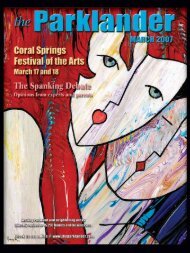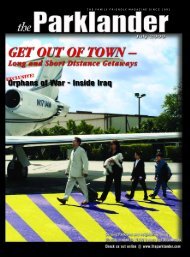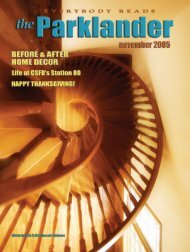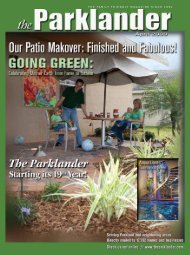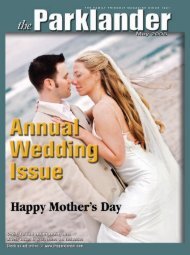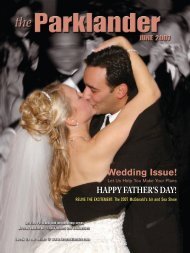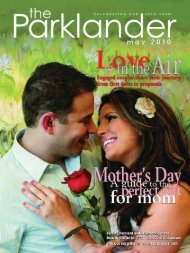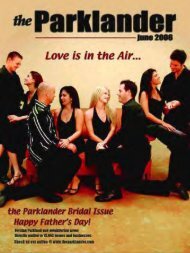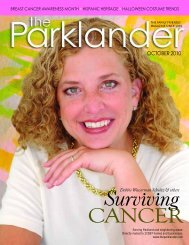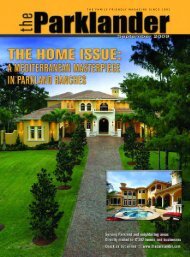February 2008 - The Parklander Magazine
February 2008 - The Parklander Magazine
February 2008 - The Parklander Magazine
- No tags were found...
Create successful ePaper yourself
Turn your PDF publications into a flip-book with our unique Google optimized e-Paper software.
“<strong>The</strong> only value of my work, if it has any art value, is absolute sincerity. I wouldnot do anything that I couldn’t feel. A dance must dominate me completely,until I lose sense of anything else.”Fang-Yi Sheu in Martha Graham’s“Sketches from ‘Chronicle’.”Photo by John DeaneAlthough her Presbyterian family did not approve at first of her dancing, it waswhen the family moved to Santa Barbara from the East Coast that Grahamjoined the Denishawn Dance Company, a company at that time who providedartistic and spiritual education for all of their dancers. After earning initialacclaim with Denishawn, Graham grew restless along with her longtime supporter,shoulder-to-cry-on, mentor, and then lover, musician Louis Horst.When she departed the school, so did he. One of my favorite quotes by Horst iswhen he told Graham that she “didn’t have to worry about the music becauseSHE was the music.” It is even a higher compliment coming from a composer.Her departure from Denishawn was necessary in the making of Graham as aserious dancer whose unique style of dance would evolve. During her earlydays, while she was struggling financially and teaching at the Eastman Schoolin New York, Graham experimented with her own dance technique, a techniquethat would revolutionize modern dance. “<strong>The</strong> fundamental form fromwhich I started is movement. And I tried to develop the body as a pulse, a centralvibration.” She shared her disapproval of the ballet technique with IsadoraDuncan and they both believed that ballet dancers were mistakenly using thebody’s center at the base of the spine.Graham believed that the center of gravity lay in the pelvis and torso, and thatthe dancer’s arms and legs would take care of themselves. Graham’s welldefinedintuitive abilities as well as her movement talents led her to not onlycreate a new form of dance (modern dance), but to give her students over theyears the permission to not only listen to their bodies, but to honor them.Graham’s classes were full of mystical illusions: “In dance, each time may be amystical or religious connotation that you feel, but principally it is the body exaltingin its strength and its own power.” As a dancer myself, I can’t imagine a morepotent declaration. Consider the following statement from a former legendarydancer in her company, John Butler: “She was a sorceress, you know in the Irishsense of having insight and being able to command people to do her bidding. Shehas superhuman power. In the studio…no one else existed for you or for her. Shewas the enchantress in the situation. Half of the time I didn’t know what the hellshe was talking about it was so mystical and spiritual.”Graham’s sensibility about the religious aspects of dance are notable and shecreated many sacred works including a work about St. Joan of Arc, and <strong>The</strong>Virgin Mary. Graham knew of her artistic fate and wanted to create a system ofmovement for dance that no one had created before. Her dance vocabulary isfull of these new movements: contraction, release, spiral, angular lines, leveragesand balances, and stunningly abrupt falls to the ground. Her work wasexplosive and sometimes disturbing. What is so extraordinary about Graham’swork as an artist and educator is her idea of the living spirit of the emotionsthat arise in the dancer’s body without any theatricality or pretense.This idea ofno pretensions, where the body is clear and honest, is what I feel is Graham’sextraordinary gift to dancers of our time.She was not afraid to show all emotions: negative, ugly, constricting, oftenstark and hard-to-watch, in a time when most audiences were seeking to bemerely entertained.Portrait of Martha Grahamand Bertram Ross,faces touching, inVisionary Recital,June 27, 1961.Photographer: Carl Van VechtenLibrary of Congress, Prints and PhotographsDivision, Van Vechten Collection, reproductionnumber LC-USZ62-106859 (b&wfilm copy neg.)Martin Lofsnes andKatherine Crockett inMartha Graham’s“Diversion of Angels.”Photo by John DeaneJanet Lynn Roseman Ph.D. is a dance critic, writer and scholar. She is theauthor of seven books, among them: “Dance Masters: Interviews with Legendsof the Dance”, and “Dance Was her Religion; <strong>The</strong> Sacred Choreography ofIsadora Duncan, Ruth St. Denis and Martha Graham”. Email her atRoseman@theparklander.com. YMGthe PARKLANDER69



